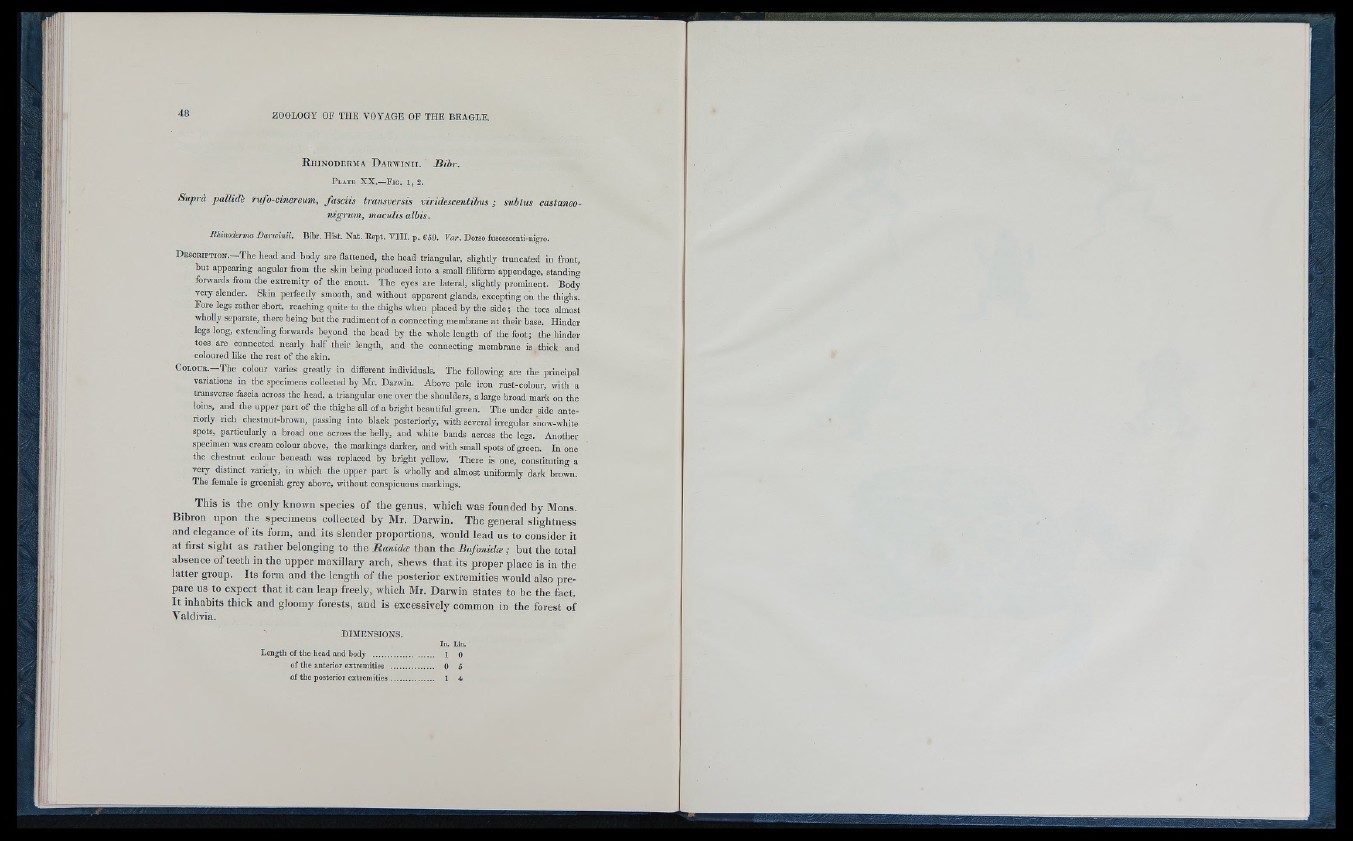
R h i n o d e r m a D a r w i n i i . B i i r .
P late X X .—F r a . 1, 2.
Suprà pallide rufo-cinereum, fasciis transversis viridescentibus ; subtus caslaneo-
nigrum, maculis albis.
mtrnderrna Dartcinii. Bibr. Hist. Nat. Eept. V III. p. 659. Far. Dorso fiiscescenti-nigro.
D e s c e ip t io n .— T h e head an d bod y are flattened, th e head triangular, slightly tru n c a ted in fro n t,
b u t ap p e arin g angula r from th e skin bein g produc ed in to a small filiform appendage, standing
forwards from th e e x trem ity o f th e snout. T h e eyes are lateral, slightly prominent. Body
very slender. S kin p erfec tly smooth, an d without a p p a ren t glands, ex c ep tin g on th e thighs.
Fore legs ra th e r short, re ach in g qu ite to th e thighs when placed by th e side ; th e toes almost
wholly separate, th e re bein g b u t th e ru d im en t o f a conne cting membrane a t th e ir base. H in d e r
legs long, e x te n d in g forwards beyond th e h ead by tb e whole len g th o f th e fo o t; th e h in d e r
toes are conne cted n ea rly h a lf th e ir length, and th e conne cting membrane is th ick and
coloured like th e re s t o f th e skin.
C o lo u r .— T h e colour varies gre atly in different individuals. T h e following are th e principa l
variations in th e specimens collected by M r. Da rwin. Above pale iro n rust-co lo u r, with a
transverse fascia across th e head, a trian g u la r one over th e shoulders, a large broad mark on the
loins, an d th e u p p e r p a r t o f th e th ig h s all o f a b rig h t beautiful gre en . T h e u n d e r side a n te rio
rly ric h che stnut-brown, passing in to black posteriorly, with several irre g u la r snow-white
spots, particula rly a broad one across th e belly, an d white bands across th e legs. A n o th e r
specimen was cream colour above, th e markings darker, an d with small spots o f g re en. I n one
th e c h e stn u t colour b en e a th was replaced b y b rig h t yellow. T h e re is one, co n stitu tin g a
very d is tin c t variety, in which th e u p p e r p a r t is wholly and almost uniformly dark brown.
T h e female is g re enish g re y above, with o u t conspicuous markings.
This is the only known species of the genus, which was founded by Mons.
Bibron upon the specimens collected by Mr. Darwin. The general slightness
and elegance of its form, and its slender proportions, would lead us to consider it
a t first sight as rather belonging to the Ranidæ than the Bufonidæ ; but the total
absence of teeth in the upper maxillary arch, shews th a t its proper place is in the
latter group. Its form and the length of the posterior extremities would also prepare
us to expect th a t it can leap freely, which Mr. Darwin states to he the fact.
I t inhabits thick and gloomy forests, and is excessively common in the forest of
Valdivia.
.DIMENSIONS.
In. Lin.
Length of the head and body .............................. 1 0
of the anterior extremities ..................... 0 5
of the posterior extremities..................... 1 4